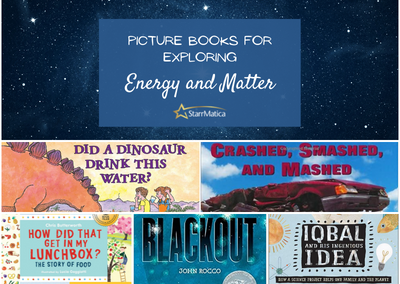Picture books are a great way to get students to examine the crosscutting concepts of the Next Generation Science Standards. New to the crosscutting concepts? Here’s a quick summary! The crosscutting concepts are one of the three dimensions of the NGSS. The seven crosscutting concepts are lenses through which your students can examine different phenomena. Using the CCC helps students to better understand both known and unfamiliar phenomena, so it can be worthwhile to spend some time helping them to dig in and really understand what each concept means. Using picture books can help make the CCC accessible to students of all ages!
The picture books shared below are fantastic for examining the crosscutting concept of Energy and Matter. Remember: If something is happening, energy is at play. To explore energy and matter with your students, choose a system. Then ask: What is the fuel: motion, heat, sound, food, light, or electricity? (Energy In) What is the system doing? (Energy Out) And finally ask: Is the system the same after the energy flowed through it?
Whether you are reading the following picture books aloud, having students explore them in small groups, or having students read them independently, the following questions can be used to help students focus on cause and effect:
- What kinds of material is this object made of?
- What happens to _______ when you put it together with ________?
- Where is matter and/or energy coming from that enters this system?
- What is the fuel: motion, heat, sound, food, light, or electricity? (Energy In)
- What is the system doing? (Energy Out)
- Is the system the same after the energy flowed through it?
- Where does matter and/or energy go that leaves this system?
- How is the energy moving in/out/within/between objects?
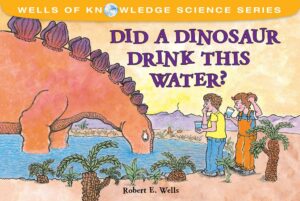 Did a Dinosaur Drink This Water? By Robert E. Wells helps us see something ordinary – the water we drink – in a new and fascinating way by explaining all about the water cycle, how molecules in our water today are really old, and how important it is to conserve water. This book can be used to highlight two big ideas: 1) Matter cannot be created or destroyed. All the water in the world is all the water in the world, and it will always be that way. 2) Energy is required to move water around the Earth.
Did a Dinosaur Drink This Water? By Robert E. Wells helps us see something ordinary – the water we drink – in a new and fascinating way by explaining all about the water cycle, how molecules in our water today are really old, and how important it is to conserve water. This book can be used to highlight two big ideas: 1) Matter cannot be created or destroyed. All the water in the world is all the water in the world, and it will always be that way. 2) Energy is required to move water around the Earth.
Question to Discuss: Will there ever be more or less water in the world? Why or why not? If not, why do the levels of water in a lake rise and fall? Why do puddles disappear after a rain? How does energy play a role in the movement of water?
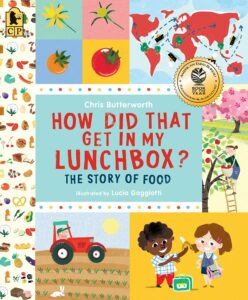 How Did That Get In My Lunchbox by Chris Butterworth is an excellent text for examining all of the energy that is needed to produce and distribute the food that gives us energy! From planting wheat to mixing dough, climbing trees to machine-squeezing fruit, this engaging book looks at the steps involved in producing some common foods for your lunchbox.
How Did That Get In My Lunchbox by Chris Butterworth is an excellent text for examining all of the energy that is needed to produce and distribute the food that gives us energy! From planting wheat to mixing dough, climbing trees to machine-squeezing fruit, this engaging book looks at the steps involved in producing some common foods for your lunchbox.
Question to Discuss: What patterns can you identify in the energy sources needed to produce and distribute food? When you think about food, how are energy and matter related?
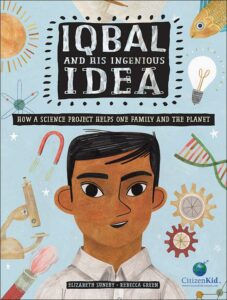 Iqbal and His Ingenious Idea: How a Science Project Helps One Family and the Planet by Elizabeth Suneby is a book about a boy wants to solve the problem of pollution from cooking fires. After research, he decides to harness the power of the sun and develops a solar cooker. Not only does this book demonstrate the power of energy from the sun, but it also highlights a way in which energy can be used to solve human issues.
Iqbal and His Ingenious Idea: How a Science Project Helps One Family and the Planet by Elizabeth Suneby is a book about a boy wants to solve the problem of pollution from cooking fires. After research, he decides to harness the power of the sun and develops a solar cooker. Not only does this book demonstrate the power of energy from the sun, but it also highlights a way in which energy can be used to solve human issues.
Questions to Discuss: What type of energy does Iqbal need? What matter is he wanting to transform with the energy? What energy source does Iqbal replace with the sun’s energy? What other problems can you think of that are or could be solved by the sun’s light and heat?
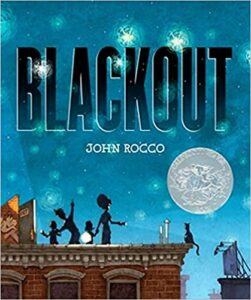 Blackout by John Rocco can help students to think about how electrical energy is integrated into almost all aspects of our everyday lives. This is the story of one hot summer night in the city when all the power goes out and a family accustomed to using electricity has to figure out other things to do.
Blackout by John Rocco can help students to think about how electrical energy is integrated into almost all aspects of our everyday lives. This is the story of one hot summer night in the city when all the power goes out and a family accustomed to using electricity has to figure out other things to do.
Questions to Discuss: What alternative forms of energy did people use before electricity to produce light and heat? How do you think electric energy is produced? Why is a loss of electricity for a long period of time a serious issue beyond just losing access to our electronics?
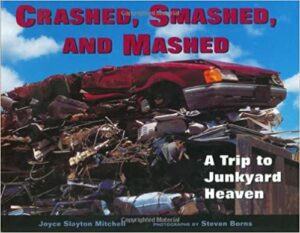 Crashed, Smashed, and Mashed: A Trip to Junkyard Heaven by Joyce Slayton Mitchell gives students a glimpse into what happens to a car once it is taken to a junkyard. Photographs and accessible text show an inside peek at how a car is taken apart and different materials are recycled and repurposed. This text is an engaging way to focus on the the concept that matter cannot be created or destroyed. It needs to be recycled and repurposed in some way. You could also explore how certain materials are used for specific parts of a car based on their properties and why material properties are integral to the recycling process.
Crashed, Smashed, and Mashed: A Trip to Junkyard Heaven by Joyce Slayton Mitchell gives students a glimpse into what happens to a car once it is taken to a junkyard. Photographs and accessible text show an inside peek at how a car is taken apart and different materials are recycled and repurposed. This text is an engaging way to focus on the the concept that matter cannot be created or destroyed. It needs to be recycled and repurposed in some way. You could also explore how certain materials are used for specific parts of a car based on their properties and why material properties are integral to the recycling process.
Questions to Discuss: Why are certain materials used for different parts of a car? Why can some materials be easily repurposed or recycled and others can’t? What happens to parts of a car that can’t be repurposed or recycled? What energy is required for a junkyard to function?
If you are a StarrMatica Texts: Science Your Way subscriber, you can check out the texts below that align with an exploration of cause and effect. Remember, each 1st – 5th grade text has multiple reading levels so all of your students can read the same content independently.
- Kindergarten: Keeping Cool in the Sun; Stay in the Shade; Warm It Up
- First grade: What is a Sound Wave; Listen Up; Communicating with Sound
- Second grade: What Do Plants Need to Grow?; Change in Matter; What’s the Matter; How Would You Sort It?; From This to That; From Trash to Treasure
- Fourth grade: Rainbow Rocks; Curious Clouds and CFCs; A Race Toward Ozone Recovery; Fossil Fuels and Clean Energy; Plants Power Our Future; Powerful Plants; Plant Power; Creating Transverse Waves; Transferring Energy; Feeling Sound Energy; Keeping Current with Energy Transfer; All About Energy; Collision Course; Energy, Heat, and Hot Chocolate; The Science of Hot Chocolate; Powering the World with the Sun; Save the Earth with Wind Power; Harnessing the Wind
- Fifth grade: The Creative Cycle of Food; The Weight of a Closed System; How Plants Grow; Of Candles and Ice Cubes; The Mysteries of Fire and Ice; Changes in Matter; Chemical Reactions Around You; Is It A New Substance; Traveling Through the Water Cycle; What Is the Water Cycle; The Size of Matter; Small, Smaller, Smallest; The Many Different Properties of Materials; The Sun’s Nourishing Energy
Not a subscriber? Click here for a free trial to access the texts above.
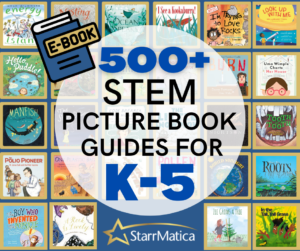 And if you are looking for additional picture books for your science classroom, check out the Perfect Picture Book Pairing Series that includes one-page guides with activities and discussion questions for hundreds of STEM-themed picture books aligned to every NGSS performance expectation!
And if you are looking for additional picture books for your science classroom, check out the Perfect Picture Book Pairing Series that includes one-page guides with activities and discussion questions for hundreds of STEM-themed picture books aligned to every NGSS performance expectation!
CLICK HERE TO PREVIEW THE PERFECT PICTURE BOOK PAIRING EBOOKS
Be sure to check out the other posts in this series to discover picture books to highlight each of the seven crosscutting concepts in the NGSS!
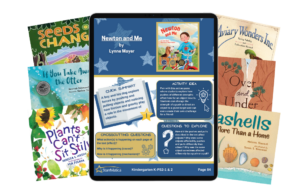
Want to save even more time with lesson ideas for 35 picture books that you can use to highlight all seven crosscutting concepts?
Enter your information below to receive your complimentary picture book guides including activity ideas, science questions, and crosscutting concept questions!

